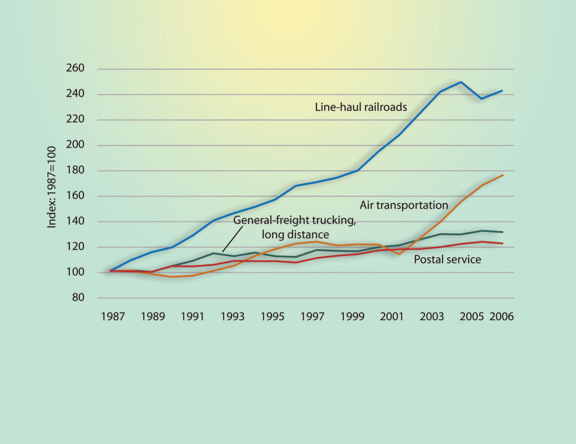Freight Facts and Figures 2008
Figure 4-2. Productivity in Selected Transportation Industries: 1987-2006
Productivity has improved in all modes, particularly railroads. Between 1987 and 2006, output-per-hour worked more than doubled in line-haul railroading but grew only 37 percent in long-distance, general-freight trucking. Line-haul railroads do not include switching and terminal operations or short-distance (or local) railroads. Long-distance, general-freight trucking establishments exclude local trucking and truck operators that require specialized equipment, such as flatbeds, tankers, or refrigerated trailers.

[PDF 259KB]
Data represented in the figure.
Output per Employee,1 Index: 1987 = 100
| Output per hour worked | 1987 | 1988 | 1989 | 1990 | 1991 | 1992 | 1993 | 1994 | 1995 | 1996 | 1997 | 1998 | 1999 | 2000 | 2001 | 2002 | 2003 | 2004 | 2005 | 2006 |
|---|---|---|---|---|---|---|---|---|---|---|---|---|---|---|---|---|---|---|---|---|
| Air transportation | 100 | 101 | 98 | 96 | 96 | 100 | 104 | 112 | 118 | 122 | 123 | 120 | 121 | 121 | 113 | 126 | 139 | 155 | 167 | 176 |
| Line-haul railroads | 100 | 108 | 115 | 119 | 128 | 140 | 145 | 150 | 156 | 167 | 170 | 173 | 179 | 194 | 207 | 224 | 241 | 248 | 235 | 242 |
| General-freight trucking, long-distance |
100 | 101 | 100 | 104 | 108 | 114 | 112 | 115 | 112 | 111 | 117 | 116 | 116 | 119 | 120 | 125 | 129 | 129 | (R) 132 | 131 |
| Postal Service | 100 | 99 | 99 | 104 | 103 | 105 | 108 | 108 | 108 | 106 | 110 | 112 | 113 | 116 | 117 | 117 | 119 | 121 | 122 | 122 |
1Based on the number of paid hours. Real gross domestic product (GDP) in the business and nonfarm business sectors is the basis of the output components of the productivity measures. These output components are based on and are consistent with the National Income and Product Accounts, including the GDP measure, prepared by the Bureau of Economic Analysis of the U.S. Department of Commerce.
Source:
U.S. Department of Labor, Bureau of Labor Statistics, Industry Productivity, available at www.bls.gov/lpc/ as of May 22, 2008.
To view Excel files, you can use the Microsoft Excel Viewer.
![]() You will need the Adobe
Acrobat Reader to view the PDFs on this page.
You will need the Adobe
Acrobat Reader to view the PDFs on this page.